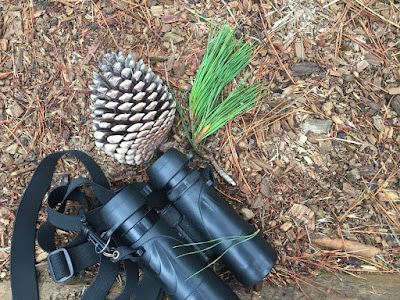 |
| Snowy peaks above the Devil's Punchbowl |
 |
Amazing rock formations at Devil's
Punchbowl Natural Area
|
 |
| Quality mixed juniper and pinyon pine woodland |
8. Single-leaf Pinyon Pine (Pinus monophylla)
I've always had a soft spot in my heart for single-leaf pinyon pine. I first knew the species at the very northern extent of its range while climbing the amazing rock formations at City of Rocks in Southern Idaho and I've seen them here in southern California near the southern extent of its range. I think the single-needle pine is unique and you are usually in a cool spot when around pinyon pines. I also like the light brown color of the fresh cones. I made a few into Christmas tree ornaments a few years ago and really like them.
The single-leaf pinyon pine is not a tall tree. The size seems to vary based on landscape position and the tallest trees I saw were approximately 30 to 35 feet in height. The single-leaf pinyon pine has (drum roll.....) one needle.
The needle is between 1.5 to 2.5 inch in length and has a slight curve to it. The cones are relatively small ranging 3.5 to 4 inches in height. Whatever the cones lack in size they make up for in nuts. The prized pinyon pine-nut is quite large and serves the local wildlife well. The grey and brown bark has cinnamon streaks and is lightly furrowed. From a distance you know your entering pinyon pine woodland by the elevation, landscape position and clumpy nature of the single-leaf pinyon pine woodland.
9. California Juniper (Juniperus californica)
I was excited to see California juniper as I drove up through the juniper woodland on the way to Devil's Punchbowl. The juniper shrubs form a mosaic of clumps on the landscape. The female shrubs were readily identified by the distinct green-grey seed cones (or juniper berries) that the male shrubs lacked.
California juniper is dioecious (male and female flowers on separate plants), shrubby with multiple trunks, and is approximately 10 to 15 feet in height. The whorled scale-like leaves of California juniper are very small and do not look like normal leaves at all. It took me a while to get over the lack of "real" leaves but I've gained a better appreciation for the genus after revisiting the Cupressaceae Family and reviewing the different genera and species. Each little leaf has a distinct dark gland which helps differentiate it from the similar looking but monoecious (male and female flowers on the same plant) Utah juniper (Juniperus osteosperma) which has an obscure leaf gland.
The male shrubs has small 2 to 3 millimeter brown pollen cones. The male shrubs have a darker appearance compared to the female shrubs which have an abundance of fleshy green-grey seed cones or juniper berries. The fleshy seed cones are round-ish with little protrusions and are 7 to 12 millimeters in size. The green-grey color of the seed cones comes from a thin glaucous film that is easily removed at the first touch. The bark of the main trunks and large branches of California juniper is grey and shaggy.
I've always had a soft spot in my heart for single-leaf pinyon pine. I first knew the species at the very northern extent of its range while climbing the amazing rock formations at City of Rocks in Southern Idaho and I've seen them here in southern California near the southern extent of its range. I think the single-needle pine is unique and you are usually in a cool spot when around pinyon pines. I also like the light brown color of the fresh cones. I made a few into Christmas tree ornaments a few years ago and really like them.
 |
| The single-leaf pinyon pine at the visitor's center is impressive |
The needle is between 1.5 to 2.5 inch in length and has a slight curve to it. The cones are relatively small ranging 3.5 to 4 inches in height. Whatever the cones lack in size they make up for in nuts. The prized pinyon pine-nut is quite large and serves the local wildlife well. The grey and brown bark has cinnamon streaks and is lightly furrowed. From a distance you know your entering pinyon pine woodland by the elevation, landscape position and clumpy nature of the single-leaf pinyon pine woodland.
 |
| Single slightly curved needle |
 |
| Cones and needles of single-leaf needle pinyon pine, note the two pine nuts remaining in the upper cone |
 |
| Grey and brown bark of single-leaf pinyon pine |
9. California Juniper (Juniperus californica)
I was excited to see California juniper as I drove up through the juniper woodland on the way to Devil's Punchbowl. The juniper shrubs form a mosaic of clumps on the landscape. The female shrubs were readily identified by the distinct green-grey seed cones (or juniper berries) that the male shrubs lacked.
 |
| The patchy mosaic of juniper woodland |
 |
| Scale-like leaves and pollen cones of a male California juniper |
 |
| Glaucous seed cones of a female California juniper |
 |
| Glaucous film on the seed cones easily rubs off |
 |
| Shaggy persistent bark of California juniper |























